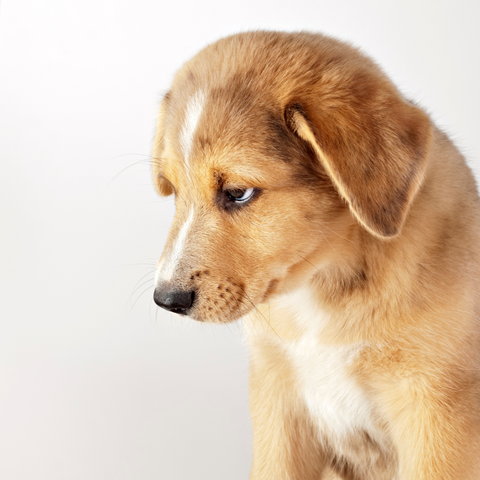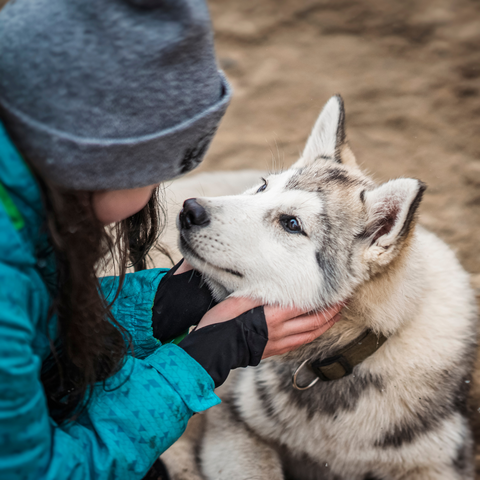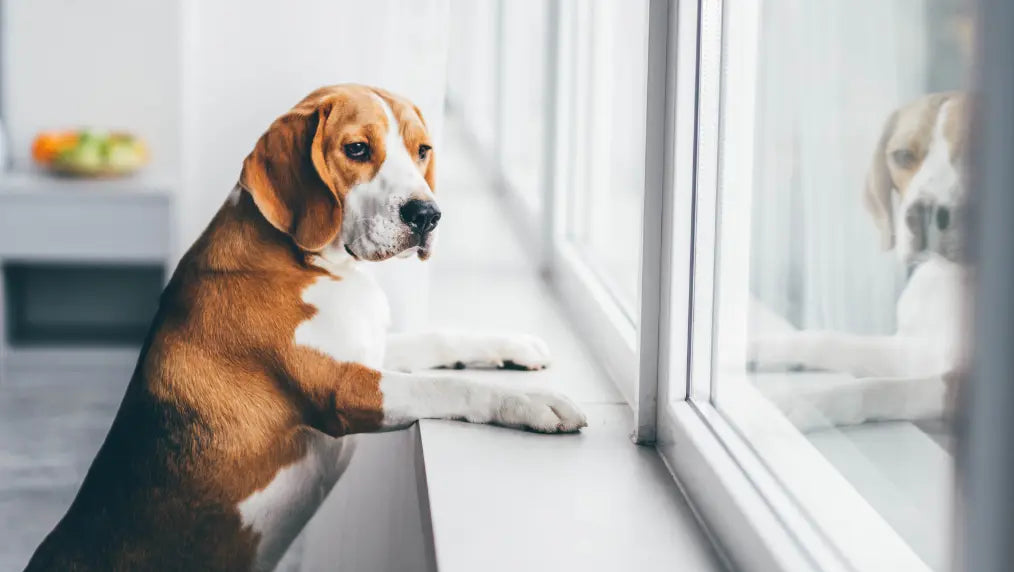Separation anxiety in dogs is a very common (but also very challenging) behavior problem that affects both dogs and dog owners. Many dogs experience issues when left home alone, or simply have isolation distress. If your dog is happy with other people but isn’t comfortable being alone, separation anxiety may be the cause. Have you wondered about dog separation anxiety, how it's defined, and how it differs from other other separation related behaviors and problems? In this article, you’ll learn several common signs and symptoms of separation anxiety in dogs, including differentiation in a dog's behavior when they develop separation anxiety. We’ll also share tips & tricks on how to treat separation anxiety in dogs.
How To Tell If Your Dog Has Separation Anxiety

Dogs communicate a lot about their feelings via their body language and vocalization. Pay close attention to what happens when your dog experiences alone-time. Dog owners are quick to use the term separation anxiety, but not all behavioral problems that occur during separation are a result of separation anxiety. Separation Distress Syndrome (SDS), commonly referred to as separation anxiety, is caused naturally by genetic factors.
Before labeling destroyed cushions or potty accidents as separation anxiety, be sure it’s not a case of inadequate training. Does your dog truly understand good manners, even when you’re not watching them? Are they 100% potty trained? One of the best ways to see what’s really going on in your absence is to get audio or video footage of your dog’s behavior while you’re away.
Before dogs were domesticated, puppies left alone at an early stage of development typically knew how to avoid danger through their connection to their mother. This trait has also allowed herds of dogs to form lifelong social relationships with each other. Now that dogs have been domesticated, this behavioral pattern of bonding and attachment with other animals has extended to humans. It's this trait that has allowed human owners to become their dog's best friend.
Typical Signs of Dogs Suffering from Separation Anxiety (or your dog being uncomfortable about being left home alone) Include:
- Panting and breathing heavy or fast
- Pacing and restlessness
- Destructive behavior – chewing, scratching, or digging
- Escape attempts – pawing and scratching excessively at doors or exit points
- Vocalization – ranges from whining to crying, barking, and howling
- Anxiety or panic when you get ready to leave
- Lack of appetite or unwillingness to eat
For canine separation anxiety, these behaviors must occur when you’re not at home. If they happen when you’re at home, too, then your dog likely experiences a different form of anxiety. Identify the anxious behaviors and what triggers that behavior, so you can help your dog feel happier. Other triggers to watch for when it comes to separation anxiety involve life changes like a sudden switch in schedule, a move to a new house, or the sudden absence of a family member, whether it’s a divorce, a death in the family, or a child leaving for college
See also: Signs Your Dog Has Imprinted On You
Dealing With Severe Separation Anxiety in Dogs

Fixing dog separation anxiety is a process that, like many other behavior problems, we deal with by removing stressors. First and foremost, ensure your dog tolerates the duration they’re left alone. Other steps to make anxious dogs deal with the behavior include the following:
1. Ensure Your Dog’s Needs Are Met
Many dogs need a nutritious and balanced diet and appropriate physical and mental exercise levels for their well-being. Audit to ensure your dog’s needs are met; some problems result from boredom, bad diet, or lack of exercise.
2. Don’t Make a Big Deal Out of Leaving
Ignore your dog before you leave if they try to participate in the situation or leave with you. When you're preparing to leave, any family member should use a simple phrase that tells your dog that you are going out alone and will return later. Repeat this sentence as you leave through the front door. This way, your anxious dog, doesn’t have to wonder whether or not they'll be joining you this time.
3. What happens when you’re gone?
Watch your dog while you’re out via a pet camera or tablet. If you see signs of separation anxiety, note how quickly your dog became anxious after you left, or how quickly they calmed down. Record specific triggers like keys or shoes that set your dog off, as well as any separation-related behaviour.
4. Create a Separation Anxiety Training Plan
A separation anxiety training plan uses gradual exposure to desensitize your dog's tolerance to your leaving. Essentially, we want to leave to be ‘no big deal’; your dog’s reaction should be boredom.
5. Start From Under Your Dog’s Stress Threshold
Your dog must feel safe and comfortable, so practice tiny departures where your dog isn’t bothered by your comings and goings. Remove reasonable triggers (e.g. put keys in your pocket and your shoes on ahead of time).
6. Regular Training Sessions
Desensitization takes time and practice to change your dog’s feelings when it comes to alone time. This is true for most dogs. Try this structured leaving (for short durations) for five days a week.
7. Speak to Your Veterinarian for Medication Advice
Medicine is also an option for many dogs, so discuss this with your Veterinarian or a veterinary behaviourist. A certified professional dog trainer with experience in separation anxiety helps implement a behaviour modification plan, as drugs may not work alone. Remember that every dog is unique. One dog may only need a little help calming down while another may require a lot more time to develop these skills. Some dogs require crate training, drug therapy, or something as simple as a puzzle toy food stuffed toy. What works for one dog may not work for another.
Separation anxiety may be preventable with proper socialization and training when your dog is a puppy. Puppies should be well socialized with other animals and people and need to learn how to have alone time and amuse themselves with their toys. When you bring your puppy out of alone time to socialize with the family, make sure that you only get them when they are quietly playing with their toys. Reward the behaviors that you want your puppy to continue. A well-adjusted puppy should do well either alone or with the family and will be less likely to have separation anxiety in the future.
How Do I Know My Dog Loves Me?

How dogs love us is a matter of perception. They look at our faces and make eye contact. They wag their tails or wiggle their butts as we walk in the door and present us with toys to play with. They desire physical affection. They want to sleep next to us.
And unlike other animals, they seek us out for comfort and safety. As pet parents, you know that they follow you around, and some get upset when we leave, even potentially to the point of anxiety. Dog interactions vary for most dogs and with each family member. But those are things we perceive as dog love. We just don't know for sure. But we do have science helping us better understand dog loving and dog imprinting.
Other Separation Anxiety Problems to Rule Out
Sometimes it’s difficult to determine whether a dog has separation anxiety or not. Do they need behavior modification? Or an anti-anxiety medication? Some common behaviour problems can cause similar symptoms. Before concluding that your dog has separation anxiety, it’s important to rule out the following behaviour problems:
1. Submissive or Excitement Urination
Some dogs may urinate during greetings, play, physical contact or when being reprimanded or punished. Such dogs display submissive postures during interactions, such as holding the tail low, flattening the ears back against the head, crouching or rolling over and exposing the belly.
2. Incomplete House Training
A dog who occasionally urinates in the house might not be completely house-trained. Their house training might have been inconsistent or it might have involved punishment that made them afraid to eliminate while their owner is watching or nearby.
3. Urine Marking
Some dogs urinate in the house because they’re scent marking. A dog scent marks by urinating small amounts on vertical surfaces. Most male dogs and some female dogs who scent marks raise a leg to urinate.
4. Juvenile Destruction
Many young dogs engage in destructive chewing or digging while their guardians are home as well as when they’re away.
5. Boredom
Dogs need mental stimulation, and some dogs can be disruptive when left alone because they’re bored and looking for something to do. These dogs usually don’t appear anxious.
6. Excessive Barking or Howling
Some dogs bark or howl in response to various triggers in their environments, like unfamiliar sights and sounds. They usually vocalize when their guardians are home as well as when they’re away.
Is There Any Way of Curing Dog Separation Anxiety Quickly?
When treating your dog's separation anxiety, you should first ensure that there's no physical ailment behind their symptoms. If you're unsure, consider bringing them to your veterinarian. After all, even a dog that's eating, playing, running, and jumping normally could be experiencing health problems. It can be hard to tell the signs of dogs suffering. Dogs have evolved to have an impressively high pain tolerance, which is often why their health problems can be difficult to detect by even the most attentive of dog owners.
Separation anxiety and separation-related treatment can take a while, depending on the dog, but it is fixable with desensitization. Another option: consult a professional separation anxiety dog trainer such as Malena De Martini’s Certified Separation Anxiety Trainers (CSATs). These trainers can create a separation-related behaviour modification plan. It’s a real hand-holding experience and you’ll get the support you need.
Exercise
Exercise can’t cure separation anxiety, but it certainly can help when treating separation anxiety (and may even help prevent it). First, make sure your puppy gets plenty of age-appropriate physical exercise. This is especially true for large, high-energy dogs with a lot of it to burn off. A tired, contented dog who’s had a brisk walk and playtime with you is more likely to settle down when you leave. Second, don’t neglect your puppy’s mental muscles. Training sessions, puzzle toys, and cognitive games are all good choices. A brain workout can be just as exhausting as a physical one: and lots of fun, too.
What Else Can Help a Dog’s Separation Anxiety?
The best thing you can do to treat your dogs with separation anxiety? Don’t leave your dog alone longer than they can handle. Solutions might involve getting a dog sitter, your dog attending daycare, or asking family or friends to help out. A dog's anxiety issues can be ongoing unwanted behaviour.
Alongside training and help with behaviour modification, some people have found success with some of the following options. This can be especially helpful for dogs experiencing lighter boredom or angst!
- Creating a safe space and leaving an old shirt with your scent behind
- Providing kong toys and stuffed puzzle toys or a food toy
- Playing white noise or music to promote relaxation
- Using calming (pet-safe) aromatherapy oils
- Trying CBD dog products
- Using natural supplements and pheromone products
Conclusion
When treating a dog with separation anxiety and distress behaviors, the goal is to resolve the dog’s underlying anxiety by teaching them to enjoy, or at least tolerate, being left alone. This is accomplished by setting things up so that the dog experiences the situation that provokes his anxiety, namely being alone, without experiencing fear or anxiety. A dog's reactions to extreme stress can be very telling about excessive attachment, medical problems, and other canine anxieties.
Separation anxiety in dogs can be a challenging issue to deal with. However, with patience, consistency, and the proper techniques, your dog can learn to be more comfortable and relaxed when you’re not around. Seeking professional advice, establish a routine of training your dog, provide plenty of exercise and mental stimulation, and consider products that may help reduce anxiety. With time and effort, you’ll help your pup overcome separation anxiety and enjoy a happier, more relaxed life.


